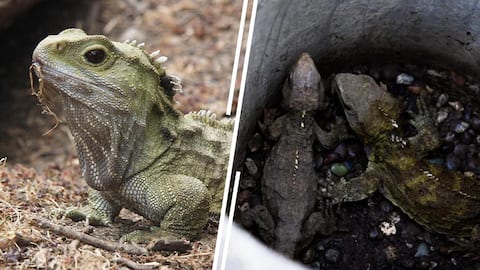Meet Henry, a 130-year-old tuatara with 3 eyes, 2 girlfriends
What's the story
Around 130 years ago, during pivotal global events like the first Olympic Games and women's suffrage in New Zealand, a unique reptile called the tuatara emerged on a small island in New Zealand. This mottled green creature, with its spiny back, faced threats from birds, rats, and even cannibalistic adult tuataras. Despite these dangers, a baby tuatara grew to nearly one kilo in weight and half a meter in length, reaching its full size by age 35.
Transition
From wild island life to public eye: Henry's journey
For several decades, the tuatara, now known as Henry, lived on Stephens Island at the northern tip of New Zealand's South Island. He spent his days hunting at night and basking in the sun during the day. However, his life took a turn when he was about 80 years old. In 1970, Henry was transported from his wild habitat to a museum in Invercargill, New Zealand's southernmost city, marking the beginning of his life as a public figure.
Fame
Henry: The oldest and most beloved Tuatara
Henry, now estimated to be between 110 and 130 years old, is believed to be the world's oldest living tuatara and the oldest resident of New Zealand. His fame extends beyond his longevity; he is also the most renowned member of his species. Despite New Zealand being home to around 150 reptile species, mostly lizards, Henry stands out as a unique representative of an ancient reptile order that coexisted with dinosaurs over 225 million years ago.
Uniqueness
Tuatara: A treasured species with unique characteristics
Tuataras, like Henry, are not just any reptiles. They are the only surviving members of the ancient reptile order Sphenodontia. These creatures hold a special place in New Zealand's culture and hearts, appearing on coins, stamps, children's books and cartoons. Scientists find them fascinating due to their unique features such as a parietal or "third" eye that detects light. They also have the slowest growth rate among reptiles but boast the fastest swimming sperm of any studied reptiles to date.
Conservation
Tuatara conservation: From natural habitats to special enclosures
Tuataras, once widespread across New Zealand, now primarily survive on a few offshore islands where introduced predators have been eradicated. Some tuataras, like Henry, live in state-of-the-art facilities where their environment, diet and health are closely monitored. Caroline Dawson, a living-species officer with the Invercargill city council, oversees a unique open-air tuatara enclosure in Invercargill's Queens Park animal reserve. This council-built facility is the only one of its kind in New Zealand that replicates a natural living environment for tuataras.
Enclosure life
Henry's life in enclosure: Two girlfriends and a careful keeper
Inside the enclosure, Dawson expertly moves between the mossy logs and plants, cautioning that they must tread carefully, as some tuatara tend to reside within the logs. She lifts a concrete lid covering a man-made burrow to reveal Lucy, a 70-year-old female tuatara. Lucy is one of Henry's two live-in girlfriends. Despite initially finding tuataras boring, Dawson has grown fond of them after feeding one and witnessing their quickness firsthand. She describes them as "killing machines."
Daily life
A glimpse into Henry's daily life and appearance
Upon lifting the last lid in Henry's enclosure, Dawson finds him lying still next to Mildred, his other septuagenarian girlfriend. During cooler months, tuataras like Henry are slow-moving and rarely eat; however, they become more active in the summer when they venture out to hunt and sunbathe. Dawson gently picks up Henry and places him on a nearby log, admiring his dappled forest floor-colored skin, pearly spikes running from head to tail, glossy black eyes, and regal demeanor.
